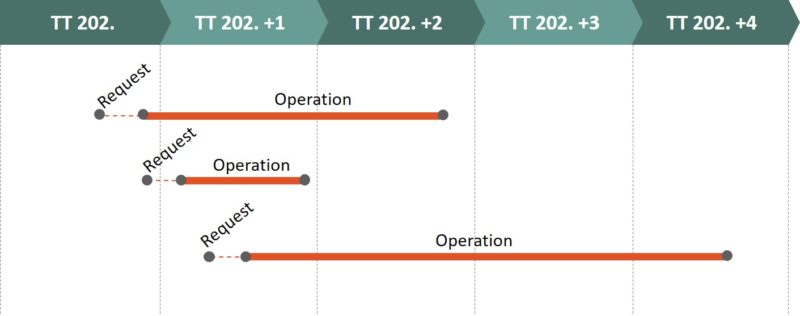Three distinct request methods have been defined to ensure that all market needs are met: Annual, Short-term and Rolling Planning Request.
Request Method 'Annual Request'
For traffic which is defined in detail long before operation starts and which requires early planning certainty for commercial and competitive reasons, it is essential to provide information on allocated capacity as early as possible. For this purpose, the ‘Annual Request’ option offers the possibility of early request and early response.
This request method has been designed mostly based on the needs of passenger traffic, for which booking systems should be opened as early as possible (aim: 6 months before the timetable change). However, on some railway lines this method might also be applicable for freight traffic, such as the rolling highway.
Annual requests can also be placed after the deadline (X-8.5), making use of residual capacity.

Request Methods for Short Term Requests
Applicants must be able to request capacity throughout the whole timetable period, including possibilities to adapt, change or cancel already allocated capacity.
IMs on the other side must be able to optimise timetables for efficient use of capacity and integrate changed and new TCRs.
To facilitate this dynamic planning, a bundle of methods is included in the TTR process:
- Ad hoc requests allow the placement of capacity requests at any time after the annual timetable planning is concluded. This includes requests for spot traffic placed only hours before the train run, but also capacity needs for recurrent train runs throughout the remaining timetable period.
- Path modifications provide the possibility to Applicants to change already allocated paths.
- Path alterations are used by IMs to change paths after allocation to accommodate TCRs and other factors which were not known at the time of the allocation.
- Applicants and IMs also have the possibility to cancel paths due to various reasons (e.g. volatile market, TCRs)
- A new process introduced in TTR is the path optimisation in which IMs can increase the efficiency of the capacity usage by adapting paths.
Request Method 'Rolling Planning Request'
In many cases, details for traffic are available only a few months before the first day of operation. Currently, ad-hoc requests are possible but limited to residual capacity and valid only for a short period of time. Also, the availability of residual capacity can currently not be guaranteed.
As a result, end customers are faced with two sub-optimal choices: either requesting early, when they do not yet know what will be needed, or requesting too late and risking to not receive capacity at all. Due to these unattractive planning parameters, freight transport often chooses road over railway transportation. Considering this situation, the urgent need for an alternative, flexible approach has become apparent.
Therefore, the TTR team has devised a new, innovative request method, the ‘Rolling Planning request’, to better meet the requirements of freight traffic in particular.
Unlike the ad-hoc request, this method will draw from capacity already assigned in the capacity model and safeguarded for the specific purpose of short-notice requests. Quick response times provide the flexibility needed to react to fluctuating market needs. At the same time the possibility for multi-annual request validity provides stability for upcoming timetable periods to secure applicants’ investments or reflect the duration of an applicants’ contract with the end customer.

To allow the coordination of IMs’/ABs’ answers to applicants, and to reduce blocked capacity and the number of change requests, Rolling Planning requests can be placed at any time between four months and one month prior to the first day of operation. Requests must comply with the parameters assigned to the respective safeguarded capacity (e.g. minimum speed, maximum train length). IMs/ABs answer as soon as possible but at the latest within a month after the request.